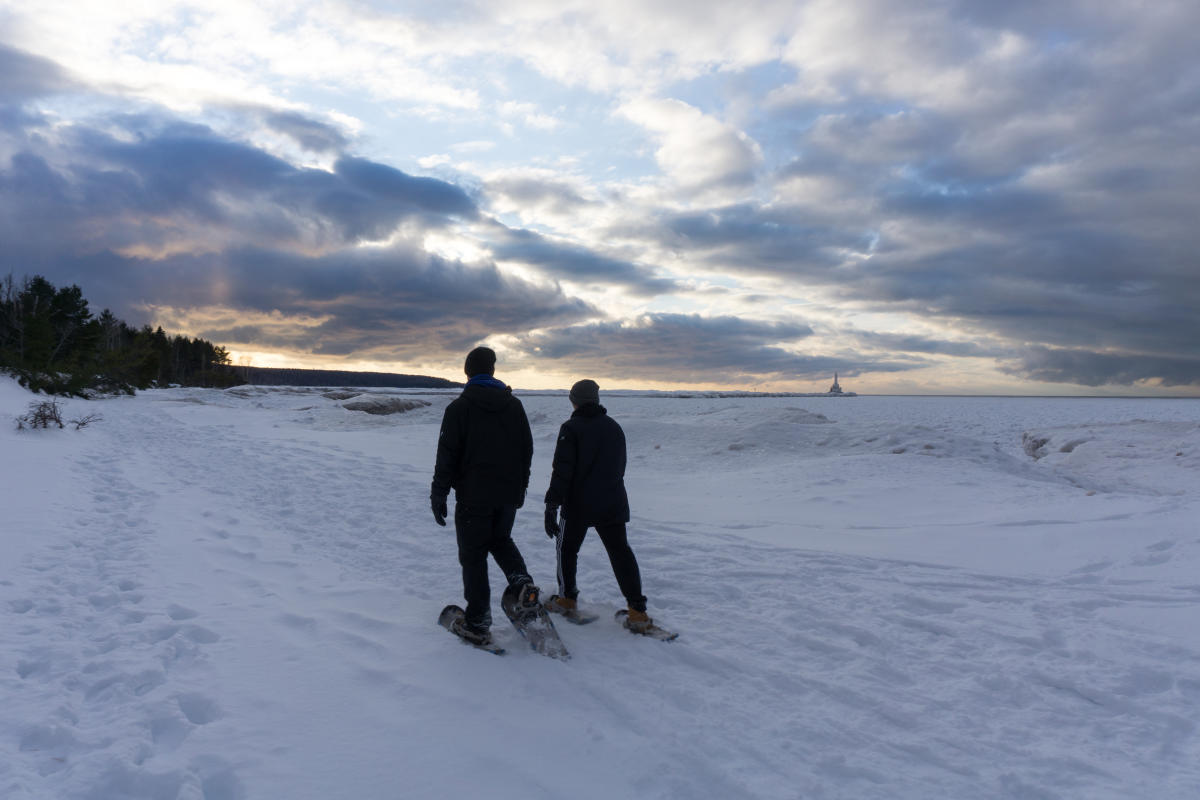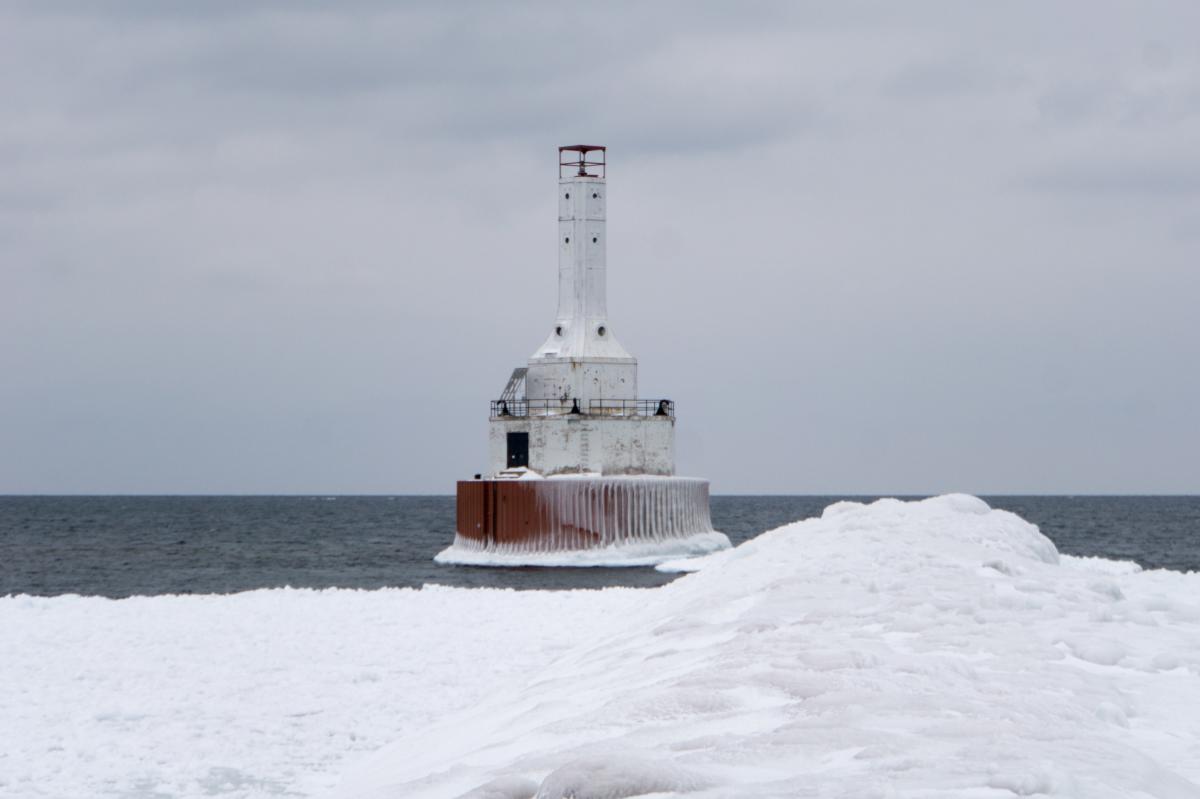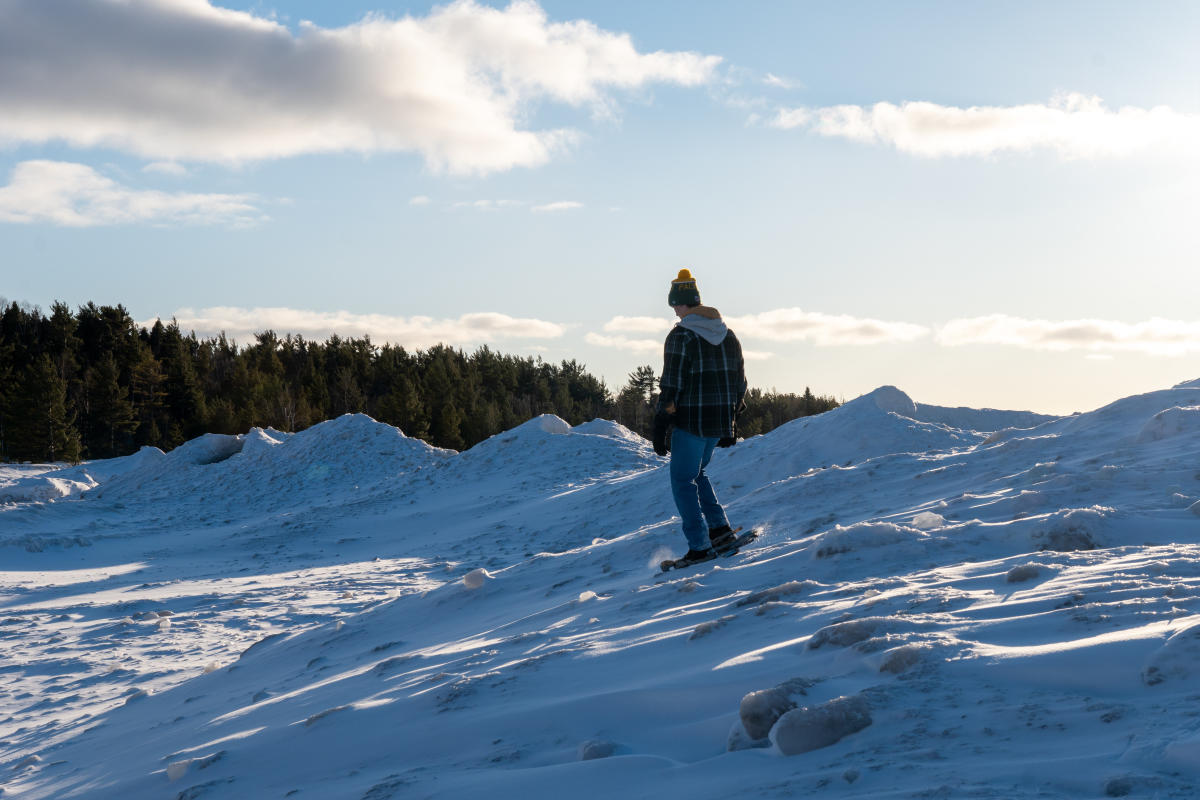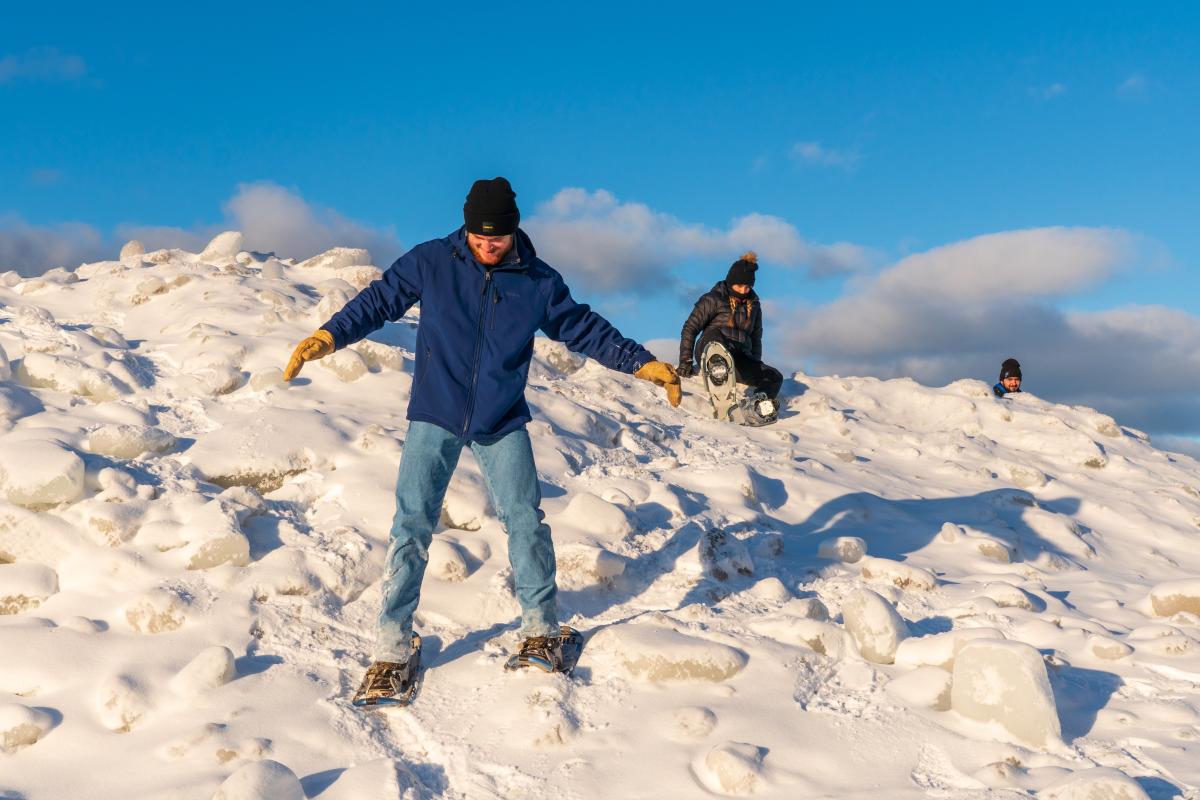McLain State Park is one of our favorite places to visit no matter the season. Most people visit during the summertime when the beach is warm and the campground bustling. During the winter this popular sightseeing spot goes into hibernation, burying itself in snow and ice. The fun doesn’t stop just because the ice cream shop closes! McLain is a great place to snowshoe and take in the sights and sounds of a long Keweenaw winter. Read on to find out how!

McLain State Park is a very scenic winter snowshoeing destination, with incredible ice formations and a beautiful frozen lighthouse.
Getting There
The journey to McLain State Park is the same in winter as it is in summer. Located roughly halfway between Hancock and Calumet on M-203, access to the park is a cinch (map). Once you’re there though, you’ll find things get a little more interesting! The main park entrance is closed in winter and the road is not plowed. However, the auxiliary entrance just to the east is still plowed a short distance. Here you’ll find a small parking area that will be the start of your journey.
The hike described here can be done in about two hours. Budget yourself some extra time if the weather is iffy, and definitely reschedule if the snow is coming down heavily. Although M-203 is plowed regularly, it is not always the highest priority during big snow dumps.
Start Your Hike
Time suit up for your adventure! From the parking area, snowshoe a short distance to the open field towards the lake. With no trees to block the wind, this area is very exposed and can be a chilly start to your hike. Hustle across the snowy expanse towards the small buildings on the far left side. You can also hike the road, which is not plowed.
Once you reach the buildings you have a couple options on where to head next: hike the forest or the shoreline. Your ultimate goal is to reach the breakwater leading out to the lighthouse, and either option will take you there. For me, which route I take to start depends on what direction the wind is blowing. The forest offers more protection for hiking into the wind compared to the shoreline. Fortunately, this route can be hiked in a loop so you can experience both. We’ll head into the forest first.
The Forest Hike
The trail through the forest begins just beyond the buildings at the far western end of the field. Look for a small sign on your right alongside the road where the trees narrow the roadway. The trail traverses a rolling dune habitat paralleling the lake and is quite beautiful. Red pines stand guard against the wind, often being plastered with snow on a single side of the tree. Seeing an entire forest like this can feel a little creepy!

The forest trail is more protected from wind than hiking along the shoreline.
Although the trail isn’t signed very often, it is fairly easy to follow as the corridor is wide and clear of vegetation. It’s possible that you’ll be able to follow snowshoe tracks from prior hikers. With how windy it gets here though, don’t be surprised if the trail drifts over. Along your hike you’ll find several benches to take a break at as well as a few side trails leading down to the lake.
Eventually the trail ends near the southwestern corner of the park, near another big field. Hike towards the (buried) parking area and buildings nearer to the shoreline to continue the adventure.
A Frozen Lighthouse
From the park facilities atop the hill, head down the snow-covered stairs to the lakeshore. The sunny beach has been transformed into an icy plain, with drifts of snow and ice blanketing the shoreline. Don’t expect to go for a dip today!

Walk along the icy shoreline towards the breakwater. You can often follow the path of previous snowshoers.
Far out at the end of the breakwater lies the Keweenaw Waterway Upper Entrance Light. The 70’ tower was completed in 1950 and is a more modern style compared to other lighthouses found in the Keweenaw. Getting close to this lighthouse is challenging and not recommended in winter. The lake ice often is unstable and the rocky breakwater very slippery after being coated in icy spray. Your best bet is to enjoy this one from afar and save the sightseeing for near-shore adventures.

The lighthouse and breakwater become covered in ice. We do not recommend walking on the breakwater during the winter, as it is often very slippery.
Ice Volcanoes
Your return journey will lead you along the lakeshore. Depending on when you visit, enormous ice volcanoes will form along the lake, some towering 20’-30’ above the lake itself. Usually the ice volcanoes form by late-January, although it’s entirely up to how cold the weather has been and how stormy Lake Superior feels.
Let’s back up though: did you say ICE VOLCANOES? Sure did! When waves crash against the shoreline, they carry with them small chunks of ice that pile up and freeze solid when exposed to frigid air. Slowly the piles grow bigger as the lake around them freezes. The weight of the ice sinks until it reaches the bottom of the lake, anchoring the piles in place. Soon waves that once crashed against the entire shoreline find themselves concentrated into a few small areas, jettisoning even more spray and ice chunks onto the growing ice mound. An ice volcano is born!

Ice volcanoes can form if the conditions are right, but be careful not to walk too close to the opening of the volcanoes.
If conditions are just right, the ice volcanoes can grow to immense size. No two ice volcanoes are alike, but they do share one thing in common: they can be dangerous. Do not climb on active ice volcanoes! Active volcanoes usually have slick, icy slopes, unstable edges, and typically still have water at the bottom of the crater. You don’t want to fall into an ice volcano because getting out may be impossible.
Often multiple lines of ice volcanoes will form along the shoreline as the winter progresses. Volcanoes located further inland from the exposed edge of the lake are more likely to be ‘extinct’ and safer to snowshoe near. You still don’t want to fall into the crater at the top because extracting yourself with snowshoes on can be difficult. Watch your footing and be on the lookout for ice balls that have been ejected from the volcano. These globules of ice are often perfectly clear and can reach bowling ball sizes!

Always watch your step when traversing Lake Superior's frozen shoreline. Large chunks of ice chunks create tripping hazards.
Lakeshore Hiking Home
After you’ve checked out the lighthouse, hike the shoreline to the northeast until you reach the first big field you started near. If the ice on the lake hasn’t solidified yet, stick to the forest for your return journey. Otherwise, if there’s a wide, stable shelf of ice behind the ice volcanoes closest to the shoreline, you’re usually in the clear. Exit the lake near the gazebo and snowshoe back to your vehicle to conclude your adventure!
Gear To Bring
Snowshoes are a must for this adventure. Although the exposed location often means snow levels are lower than other locations, the ice along the lake is very challenging to walk on with just boots. Snowshoes with crampons or metal ‘toes’ are a must for the best traction. Wooden snowshoes are fine on flatter terrain but may be slower overall. Snowshoe rentals (with crampons) are available at Down Wind Sports in Hancock, or Cross Country Sports in Calumet. It’s possible to use cross country skis too if you’re really adventurous. The trail and lakeshore aren’t groomed so you’ll be breaking trail. Fun!

Keep a safe distance from the edge of the ice. You do not want to fall into freezing Lake Superior waters.
You’ll want to bring an extra layer on this hike, especially one that is wind-proof. Winds are always higher along the lakeshore and can sap your warmth quickly. Thick gloves and hats are a must, as are face coverings to protect against the wind. Stash water and snacks in pockets to keep them from freezing. As always, pack out any trash and leave what you find on your adventure.
Interested in updates, travel tips and quirky information about the Keweenaw? Just sign up for the Keweenaw Explorer, our monthly e-newsletter. Complete the form…

